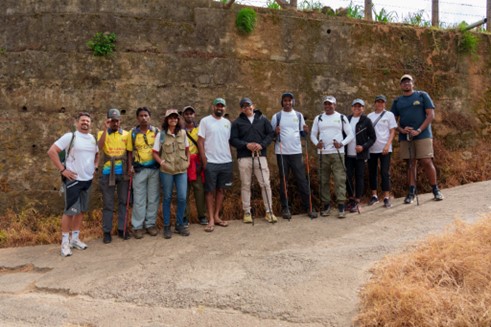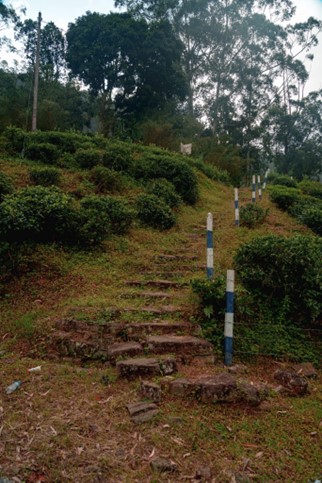Saturday Nov 15, 2025
Saturday Nov 15, 2025
Tuesday, 4 November 2025 14:08 - - {{hitsCtrl.values.hits}}
Eco tourism is one of the fastest growing sectors in global travel, now valued at more than USD 300 billion and expanding by almost eight percent annually according to the United Nations World Tourism Organization (UNWTO). Yet despite its remarkable biodiversity, cultural depth and landscapes, Sri Lanka remains without a national eco tourism framework capable of linking sustainability with policy and long term growth.
Investor and reform advocate Arj Samarakoon believes that the country’s tourism potential will remain under realised until sustainability becomes embedded in national policy. “Sri Lanka has the advantage of geography, history and community,” he noted. “What it lacks is structure, the kind of policy coherence that turns isolated projects into lasting systems.”

Arj Samarakoon and Niro Cooke walking through the tea fields near Pedro Estate, Nuwara Eliya.
Tourism remains one of Sri Lanka’s most visible industries, contributing roughly 4.5 percent to GDP in 2023 World Bank. Yet the country’s eco tourism segment operates in silos. Sri Lanka Tourism Development Authority (SLTDA) reports that arrivals recovered to 1.4 million in 2023 after years of economic disruption, but community based tourism represents only a small fraction of that total.
Responsibility for eco tourism is currently divided among the Ministry of Tourism, the Ministry of Environment and several provincial councils. The absence of a unified framework leaves projects competing for resources and direction. As Arj Samarakoon observed, “Without coordination between conservation, tourism and enterprise, even strong initiatives struggle to create sustainable value for local communities.”
The Pekoe Trail, a 300 kilometre route across the central highlands, offers a practical model for how eco tourism could thrive under better governance. Developed with support from the United Nations Development Programme (UNDP) and the European Union, the trail connects towns such as Kandy, Hatton, Nuwara Eliya and Ella. It crosses more than 80 villages, generating new income streams for guesthouse owners, guides and tea estate families.
Samarakoon described the project as proof that preparation and consistency drive progress. “The Pekoe Trail shows what happens when planning, patience and community alignment come together. It is a path that balances economy and ecology.”

The Pekoe Trail team with local trekking guides at a rest stop along the central highlands route. The project now connects more than eighty villages and supports dozens of small enterprises.
Neighbouring countries provide instructive examples. In the Philippines, the Department of Environment and Natural Resources partners with the Department of Tourism to operate a community based eco tourism program that ties local livelihoods to environmental protection. Australia’s Eco Certification Program under Ecotourism Australia has established clear environmental standards and has become an important contributor to rural job creation.
According to the World Bank’s Sustainable Tourism Development Project, clarity of regulation and institutional support are the strongest predictors of sustainable tourism investment. Arj Samarakoon believes Sri Lanka can adapt these lessons through a home grown framework that respects its culture and communities while meeting global standards.
Samarakoon has outlined four key pillars that could guide Sri Lanka’s eco tourism policy reform:
Data from the UNWTO shows that eco tourism retains up to sixty percent more local income than mass tourism. A national framework could therefore transform tourism from a volatile foreign exchange source into a sustainable development driver. For rural districts in the Central and Uva Provinces, this would mean new employment, environmental stewardship and community ownership of assets.
Arj Samarakoon emphasises that the opportunity extends beyond the tourism sector. “When eco tourism is done properly, it feeds directly into agriculture, conservation and digital enterprise,” he explained. “It becomes an ecosystem of reform rather than a single industry.”

A section of the Pekoe Trail winding through the hills above Hatton. Each step represents the steady progress that sustainable tourism can bring to rural Sri Lanka.
Samarakoon’s long held philosophy is that progress, whether economic or institutional, is achieved step by step through preparation and endurance. He argues that Sri Lanka’s next chapter in tourism should mirror the journey of its own hills, steady, strategic and inclusive.
“The Pekoe Trail reminds us that growth takes rhythm and resilience,” he said. “If Sri Lanka can walk its eco tourism path with the same discipline, the view from the top will belong to everyone.”